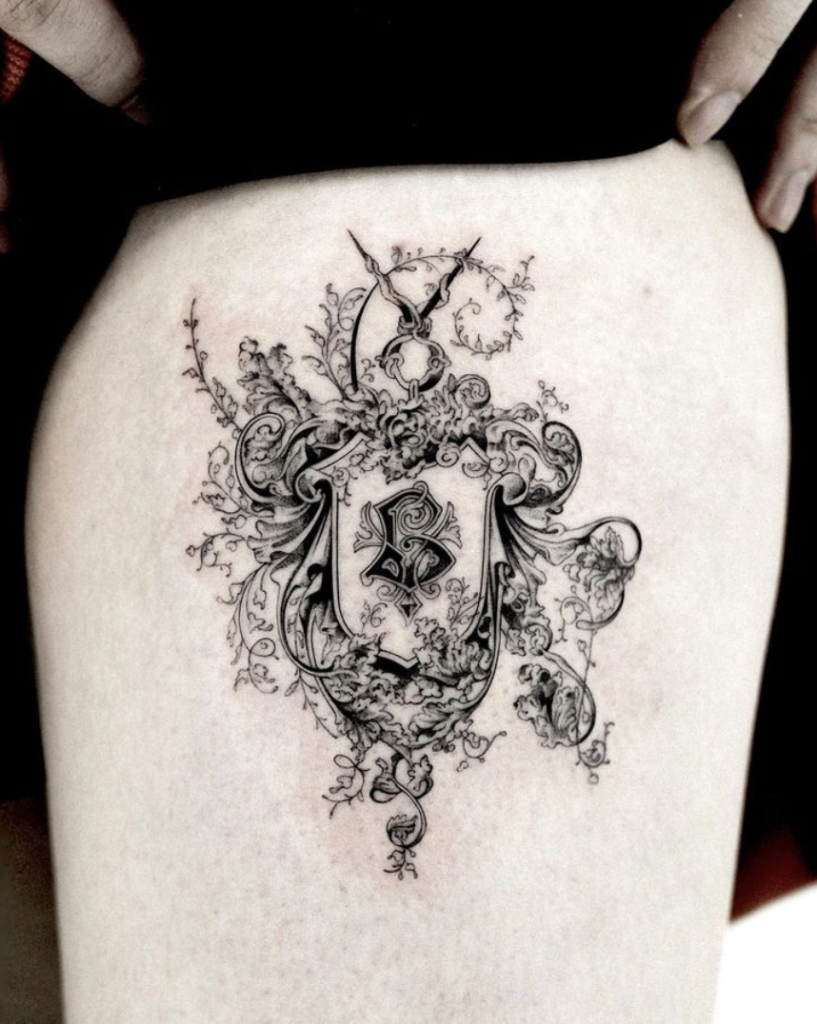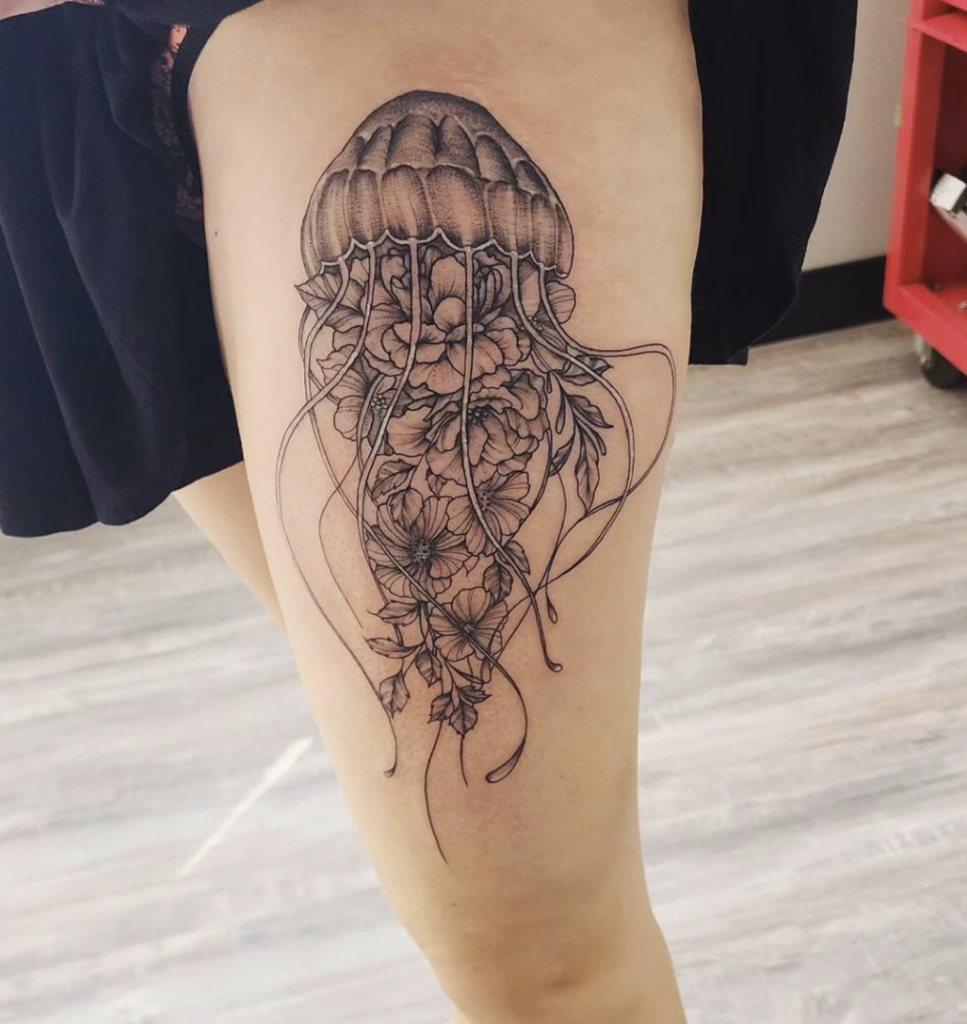
The thigh is one of the most ideal canvases when it comes to body art. Why?
This space has a lot of surface area to work with, the natural movement of this leg area takes the coolness factor up a bit, plus when it comes to pain, the thigh is way lower on the scale compared to the bottom of the leg.
A thigh tattoo is a perfect choice for those who want a visible tattoo that doesn’t hurt too much while the thigh’s larger surface area allows for detailed tattoo designs to be created with ease.
So, what are all the areas of the thighs to consider for a thigh tattoo, and what are the differences?

Thigh Tattoo Placement
For a thigh tattoo, you’ll have to choose between a front of thigh tattoo, side thigh tattoo, inner thigh tattoo, and back of thigh tattoo.
The front of the thigh is the most common spot for a thigh tattoo as it’s considered not to be painful and the process is pretty easy – you just need to lie flat on your back while your artist works their magic.
Another spot of the thigh that is less sensitive is the side of the thigh.
“…you’ll often see huge ornate flower thigh tattoos (especially intricate lotus flowers), giant mandala tattoos, and elaborate skull tattoos as popular side thigh tattoo designs,”
Hush Aesthetics

The back of the thigh is considered to be more sensitive compared to the front and side of the thigh. The closer you get to the back of the knee, the more painful the experience will be due to the thinner skin in this area.
“You might get away with getting a leg tattoo smack dab in the middle of your thigh-back without excess tenderness, but the lower and upper parts are going to be just as sensitive, or even más sensitive than the inner thigh.”
Hush Aesthetics
Then you’ve got the most sensitive of the thigh tattoo placement: The inner thigh. This area is softer and more delicate compared to the other areas of the leg. Plus, this area does experience more friction, so aftercare and tattoo longevity can be tricky.

Are Thigh Tattoos Painful?
As we said above, the pain level of a thigh tattoo depends on the area of the leg getting tattooed. However, generally speaking, the thigh is lower on the pain scale compared to other areas of the body. Healthline explains,
“This part of the body is well padded with fat and has few nerve endings. The upper outer thigh is one of the least painful places to get a tattoo, with pain low to low-moderate in most people.”

The place with the most muscle and cushioning for a leg tattoo is the upper thigh. Fat is stored here so the nerves and bones are protected.
“The lower the placement of the tattoo is on the thigh the more pain you can expect. The lower thigh connects to the knee (muscles and nerves), where the nerves are less protected and the bone proximity is higher,”
Saved Tattoo
To make the tattoo process more comfortable, you can use numbing cream. But, it’s important to chat with your chosen tattoo artist about this. Some artists do not use numbing products, so you’ll need to bring your own to your appointment.

Are Thigh Tattoos Hard To Heal?
This depends greatly on your tattoo artist and how well you look after your tattoo during the healing process.
What makes a thigh tattoo hard to heal is clothing.
“A fresh tattoo will scab while it heals. Anything that brushes on the scab can cause it to fall off, causing damage to both your skin and the design while also prolonging the healing process,”
Authority Tattoo
During the healing process, it’s essential to allow your tattoo to breathe so you shouldn’t wear constricting pants.
This may mean you need to plan ahead of time for your thigh tattoo by taking some time off of work so that you can walk around your home in shorts, your underwear, or loose sweatpants while your tattoo heals.

How Long Does A Thigh Tattoo Take To Heal?
A tattoo can take up to a month to heal, but improper aftercare can slow down the process. After your thigh tattoo is complete, your tattoo artist will give you a list of aftercare instructions to follow.
This will include washing your tattoo regularly (with clean hands), patting it dry gently, and moisturizing it with a gentle lotion.

It’s also important to keep your tattoo out of the sun while it’s healing because you cannot put SPF on fresh ink.
“A new tattoo is like an open wound, and applying sunscreen to it can cause the chemicals to enter the skin and cause irritation, itchiness, and infection. Please wait for the healing process to complete before applying sunscreen on a fresh tattoo,”
Brush On Block
You know your tattoo is completely healed when you can run your fingertips over the design and you can’t feel a difference between tattooed skin and non-tattooed skin.

What Not To Do After A Thigh Tattoo
Try not to put any pressure on your tattoo. Any rubbing against the tattoo can displace the ink and cause a prolonged healing period.
Sorry Mom Shop advises being careful about how you sleep with a fresh tattoo,
“Avoid sleeping directly on your new tattoo, at least the first four days. A healing tattoo needs lots of fresh air and oxygen, so try not to smother it while sleeping.”
You can prop your inked leg up on a few pillows to reduce swelling.
Also, cancel any pool parties or beach days during your healing period. Don’t submerge your fresh tattoo in water – hot tubs, rivers, the ocean, and pools can have a ton of bacteria that can cause an infection.

If you’ve got a particularly detailed tattoo design in mind but you’re weary of the pain that comes with getting inked, choosing the thigh for your tattoo placement could be the perfect choice for you.

